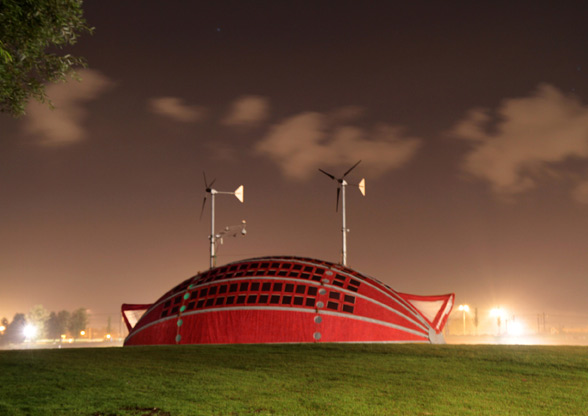
A cross-cultural educational media project with the San (Bushmen) on location in the Kalahari Desert.
The World in a Shell (polliniferous project) is used as a vehicle for intercultural exchange and intellectual cross-pollination underpinned by social and ethical concerns. WiaS explores ways in which technology might assist the adoption of an autarkic and nomadic life-style – something potentially desirable for the twenty first century world citizens.
www.worldinashell.net/concepts/modernnomadism
As a high-tech multi-purpose vessel, WiaS is based on the dimensions of a standard sea container, yet folds out to be seven-fold of its original size. With a self-sufficient and energy-independent infrastructure, WiaS can function in any climate or geographical environment. It is powered by renewable energy (wind and solar) with an immense energy storage capacity and digital interface.
www.worldinashell.net/datarelay
The lego-like interior accommodates a wide range of facilities, including a multi-media studio, water recycling, and a conventional household set-up (that can be used for feeding, for example, a film-crew). In technical terms it is the world’s most powerful micro-grid technology for its size running on renewable energy. WiaS also utilises technologies that can be used without degrading either the environment or the values and lifestyles of the peoples it visits.
www.worldinashell.net/facts/construction
WiaS has been developed across a period of four years at the Delft University for Technology through a process of practically engaging a wide variety of faculties, received grants, and sponsorship through 75 institutions (and other sponsors). WiaS was also honoured to receive the patronage by UNESCO Paris for this phase. To date, about 50 years of labour from both highly intelligent individuals and engineering companies have been invested in WiaS. The ideas and technology used to develop WiaS are clearly more than 20 years ahead of their time.
www.worldinashell.net/facts/development
www.worldinashell.net/facts/people
Technology advancement for its own sake was not the goal; by contrast, our aim was to develop a vessel that facilitates personal interaction, the sharing of knowledge, and to suggest broad solutions regarding autonomy and decentralisation.
www.worldinashell.net/facts_main
WiaS functions as an artist laboratory in order to both tell and collect stories. On invitation from the San (Bushmen) of a tiny village in the fast Kalahari Desert, we plan to install our “coming of age” interdisciplinary-media project – essentially staged in a swap-shop situation with local people.
www.worldinashell.net/cables/index.php/_cables/location-scouting-d-kar/
WiaS will be remodelled into a cinema, a stage for theatre, and a workshop for film- making. Its aesthetics and interior acoustics are designed to maximise inspiration.
www.flickr.com/photos/worldinashell/6333987215/in/photostream
By installing the project in the village and working together with the locals we aim to uncover contemporary interpretations of myths and real life problems in the lives of indigenous youth ‘in situ’. Essentially, we will offer them handles with which to document their own stories. These stories will be collected, discussed and then transferred onto film. Visions to be understood all over the world, told in the San’s unique and cheerful way, with a view to bringing their tacit knowledge alive. In this context, expressions of joy, smiles and laughter might provide a cross-cultural reference with which to demonstrate social satisfaction.
www.worldinashell.net/cables/index.php/_cables/tsodilo-hills-location-scouting/
How are happiness and fortune intertwined? To what extent are we able to shape our destiny via our individual input? What makes us differentiate between adopting an optimistic and a pessimistic outlook? WiaS aims to demonstrate that it is often simply a matter of cultural definition that determines the various ways in which life is interpreted through spoken fables, tales and stories.
www.worldinashell.net/cables/index.php/_cables/building-huts-at-dqae-qare-farm/
Humanity is certainly looking for tools with which to construct new thought. The staging their tales and stories can help to facilitate this. For millennia, the San have dealt with all manner of extreme and unexpected circumstances whilst maintaining a characteristically positive outlook. Aspects of this positive thinking can be seen unfolding in their progressive social cohesion, their relation to the environment, and their preference for a nomadic existence. Nevertheless, younger generations are now facing new challenges. Can they manage to resist the ever-growing pressures and blessings of modernity?
www.worldinashell.net/cables/index.php/_cables/hunting-party-at-dqae-qare-farm/
WiaS is an interdisciplinary project operating within the liminal spaces between art, science and education – with references to environmental/green living and humanitarian issues (specifically disaster management and rural challenges). Significantly, on the 29.10.2012, WiaS – the polliniferous project received the patronage for Botswana by Irina Bokova, Director-General of UNESCO in Paris.
About the project:
http://www.shareable.net/blog/building-the-old-world-in-a-shell-of-the-new
http://www.mtschaefer.net/entry/world-shell/
http://inhabitat.com/wind-and-sun-powered-shipping-container-unfolds-into-traveling-cultural-exhibition
http://popupcity.net/2011/01/
https://intranet.tudelft.nl/index.php?id=58190&L=1
About the artist:
http://www.worldinashell.net/concepts/artist.html
http://v2.nl/archive/people/hans-kalliwoda/
http://www.and.org.uk/journal/people/hans_kalliwoda.php
http://www.youtube.com/watch?v=xAmcB3DlvZQ
Image for public dissemination (please download here):
http://www.worldinashell.net/
Image credits: Michi Maier (courtesy of Blindpainters Foundation)




